Study of the Two-Phase Flow Characteristics of a Damping Orifice in an Oleo-Pneumatic Shock Absorber
Abstract
1. Introduction
2. Working Principle and Analysis of the Shock Absorber
2.1. Working Principle of the Shock Absorber
2.2. Oil Damping Force
3. Model Design and Grid Division
4. Numerical Simulation and Experimental Design of a Two-Phase Flow
4.1. Conservation Equation for the Numerical Simulation of a Two-Phase Flow
4.2. VOF Method
4.3. Boundary Conditions and Solution Settings
4.4. Shock Absorber Parameters Design
5. Analysis of the Numerical Simulation Results
5.1. Effect of the Orifice Length on the Shock Absorber Performance
5.2. Effect of the Orifice Diameter on the Shock Absorber Performance
6. Conclusions
- The results of the oil volume fraction contour showed that the oil flowed out of the damping orifice and mixed with nitrogen mainly in the form of a turbulent jet when the oleo-pneumatic shock absorber was working. When the oil jet hit the upper wall, it fell off the upper wall with gravity. The continuous compression of the nitrogen cavity and oil cavity made the two phases of oil and nitrogen acquire a mutually coiling complex movement, and a large amount of oil moved down along the upper wall. Finally, nitrogen was compressed in the center of the nitrogen cavity. It can be seen from the temperature contour that the middle of the nitrogen chamber had the highest temperature, and the temperature rose to about 25 °C, which indicated that nitrogen absorbed a lot of energy.
- With the increase of the orifice length, the maximum pressure, maximum speed and oil damping force inside the shock absorber decreased; the values of these parameters increased for orifice lengths of 5–15 mm and were basically stable for lengths over 15 mm. The orifice length had a great influence on the internal temperature of the shock absorber, and the maximum temperature was the lowest for a length of 15 mm. From the analysis of the flow angle of the small orifice, it appears that an increase in the hole length will increase the flow time through the small orifice of the oil attached to the small orifice, making the flow rate of the oil more stable; in this way, the damping force and other parameters of the oil will be reduced, but the changes will not be large.
- Increasing the diameter of the oil orifice had a great influence on the performance of the shock absorber. With the increase of the diameter of the oil orifice, the maximum velocity decreased from 100.97 m/s to 21.56 m/s, the maximum pressure decreased from 10 MPa to 6.5 MPa, and the oil damping force decreased from 54.13 KN to 2.28 KN. The temperature decreased as the diameter of the orifice increased. As a whole, the changes were the largest for diameters between 10 mm and 13 mm, and then the values tended to stabilize. It can be seen that the selection of the oil orifice diameter had a great influence on the performance of the shock absorber. This indicates that a too large oil orifice diameter will make a shock absorber lose its damping effect.
Author Contributions
Funding
Data Availability Statement
Conflicts of Interest
References
- Yazici, H.; Sever, M. Active control of a non-linear landing gear system having oleo pneumatic shock absorber using robust linear quadratic regulator approach. Proc. Inst. Mech. Eng. Part G J. Aerosp. Eng. 2017, 232, 2397–2411. [Google Scholar] [CrossRef]
- Pecora, R. A Rational Numerical Method for Simulation of Drop-Impact Dynamics of Oleo-Pneumatic Landing Gear. Appl. Sci. 2021, 11, 4136. [Google Scholar] [CrossRef]
- Bharath, M.; Singh, P.; Kantheti, B. Determination of Influence of Parameters on Undercarriage Shock Absorber. SAE Int. J. Aerosp. 2018, 11, 85–114. [Google Scholar] [CrossRef]
- Ding, Y.W.; Zhang, Z.H.; Wei, X.H.; Gan, S.Y. Influence of Orifice Geometry Parameters on Landing Gear Drop Dynamics. Aeronaut. Comput. Tech. 2018, 48, 30–33. [Google Scholar]
- Nie, W.Z.; Lu, J.M.; Ma, Y.J.; Chen, X.D. Analysis on the characteristics of the damping hole of landing gear buffer. Mach. Tool Hydraul. 2021, 49, 151–155. [Google Scholar]
- Heirendt, L.; Liu, H.H.T.; Wang, P. Aircraft Landing Gear Thermo-Tribomechanical Model and Sensitivity Study. J. Aircraft. 2014, 51, 511–519. [Google Scholar] [CrossRef][Green Version]
- Lou, R.; She, S.Q.; Lu, D.F. Oleo-pneumatic mixed shock absorber landing pressure analysis of landing gear. Adv. Aeronaut. Sci. Eng. 2020, 11, 380–386. [Google Scholar]
- Jiao, F.J. Oil damping energy loss analysis of landing gear shock absorber. Proc. Inst. Mech. Eng. Part G J. Aerosp. Eng. 2019, 233, 3096–3109. [Google Scholar] [CrossRef]
- Wu, W.; Tang, H.; Zhang, S. High-Precision Dynamics Characteristic Modeling Method Research considering the Influence Factors of Hydropneumatic Suspension. Shock Vib. 2020, 2020, 8886631. [Google Scholar] [CrossRef]
- Deng, P.Y.; Gu, Z.Q.; Zhang, S.; Ma, X. Research on two-phase flow mechanics properties of hydro-pneumatic suspensions considering physical property varieties. China Mech. Eng. 2017, 17, 2043–2048. [Google Scholar]
- Ahmad, M.A.; Shah, S.I.A.; Shams, T.A.; Javed, A.; Rizvi, S.T.U.I. Comprehensive design of an oleo-pneumatic nose landing gear strut. Proc. Inst. Mech. Eng. Part G J. Aerosp. Eng. 2020, 235, 1605–1622. [Google Scholar] [CrossRef]
- Wang, P.; Lv, J.Z.; Bai, M.L.; Wang, Y.; Hu, C. Numerical investigation of the flow and heat behaviours of an impinging jet. Int. J. Comput. Fluid Dyn. 2014, 28, 301–315. [Google Scholar] [CrossRef]
- Fan, W.; Anglart, H. Progress in Phenomenological Modeling of Turbulence Damping around a Two-Phase Interface. Fluids 2019, 4, 136. [Google Scholar] [CrossRef]
- Saad, M.M.M.; Mohd, S.; Zulkafli, M.F.; Samiran, N.A.; Didane, D.H. CFD Simulation Study on the Performance of a Modified Ram Air Turbine (RAT) for Power Generation in Aircrafts. Fluids 2021, 6, 391. [Google Scholar] [CrossRef]
- Ding, Y.W.; Wei, X.H.; Nie, H.; Nie, H.; Li, Y.P. Discharge coefficient calculation method of landing gear shock absorber and its influence on drop dynamics. J. Vibroeng. 2018, 20, 2550–2562. [Google Scholar] [CrossRef]
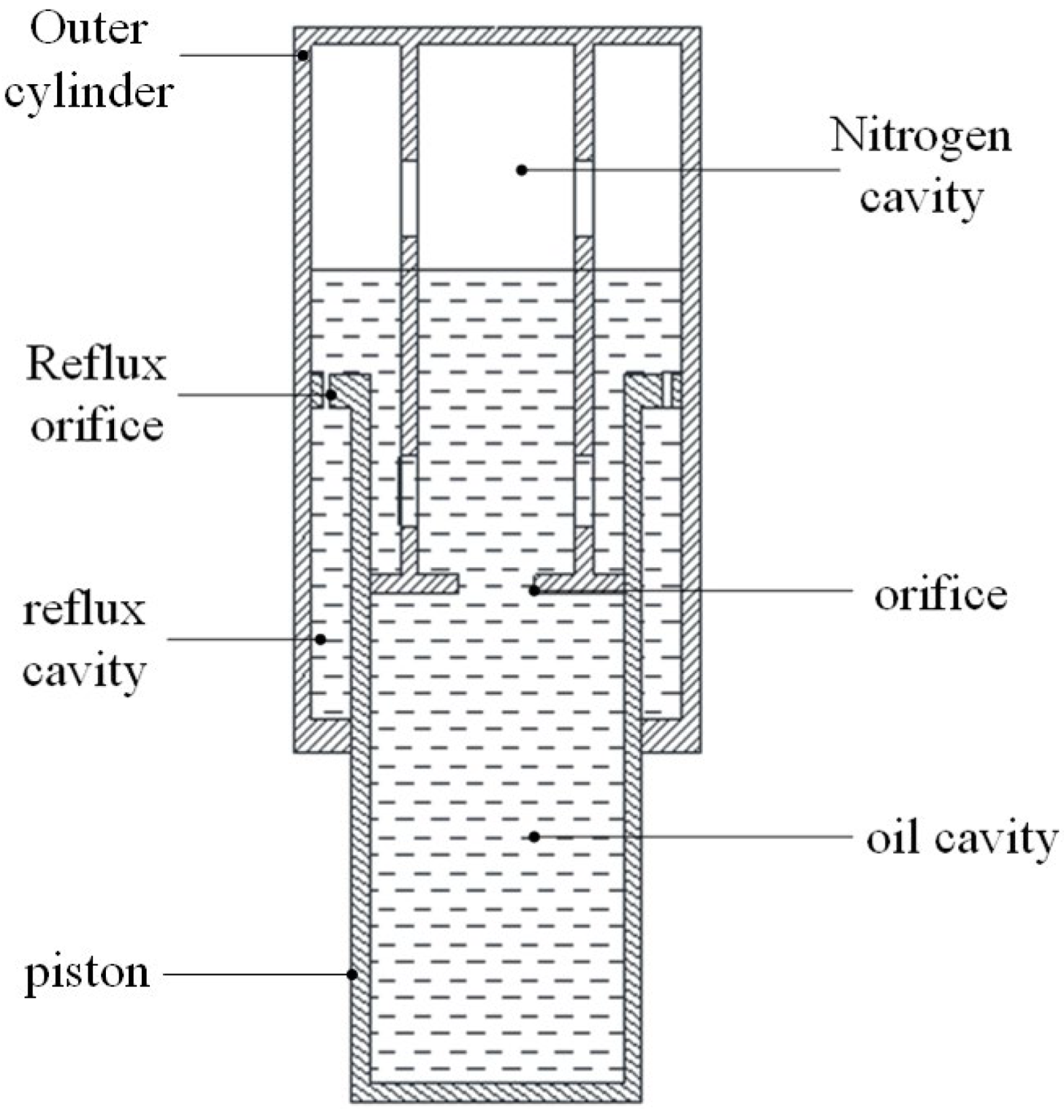
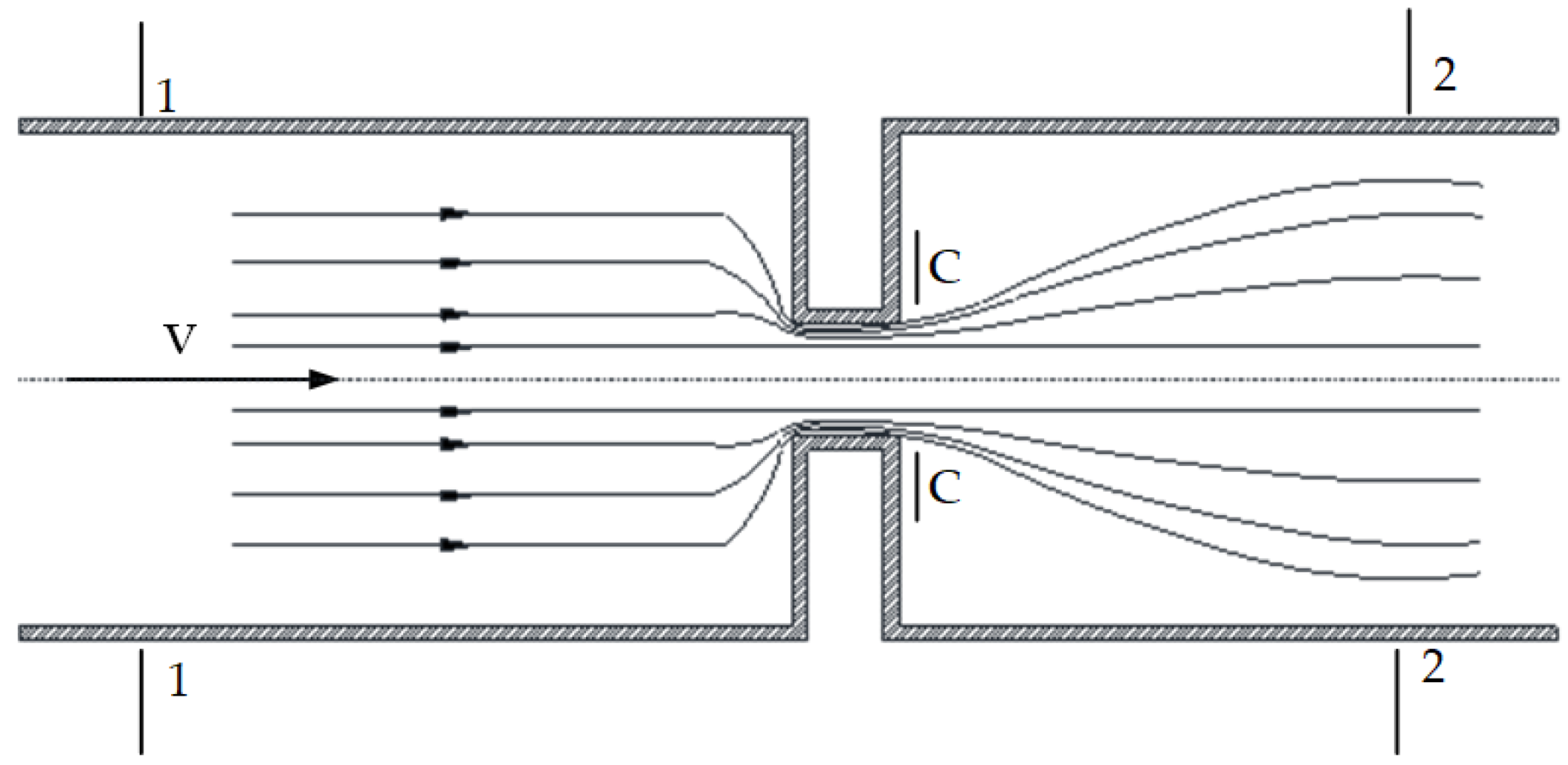



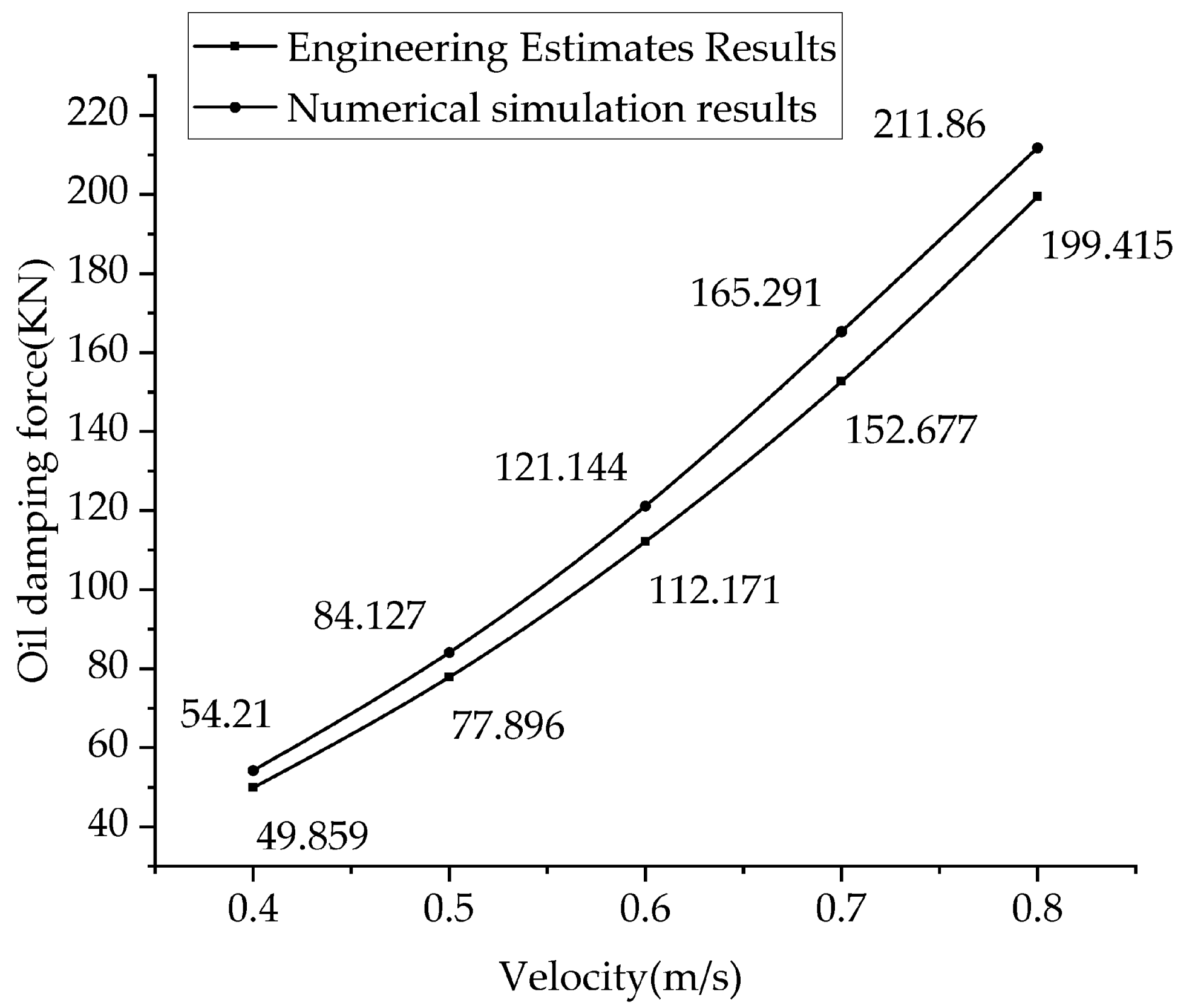
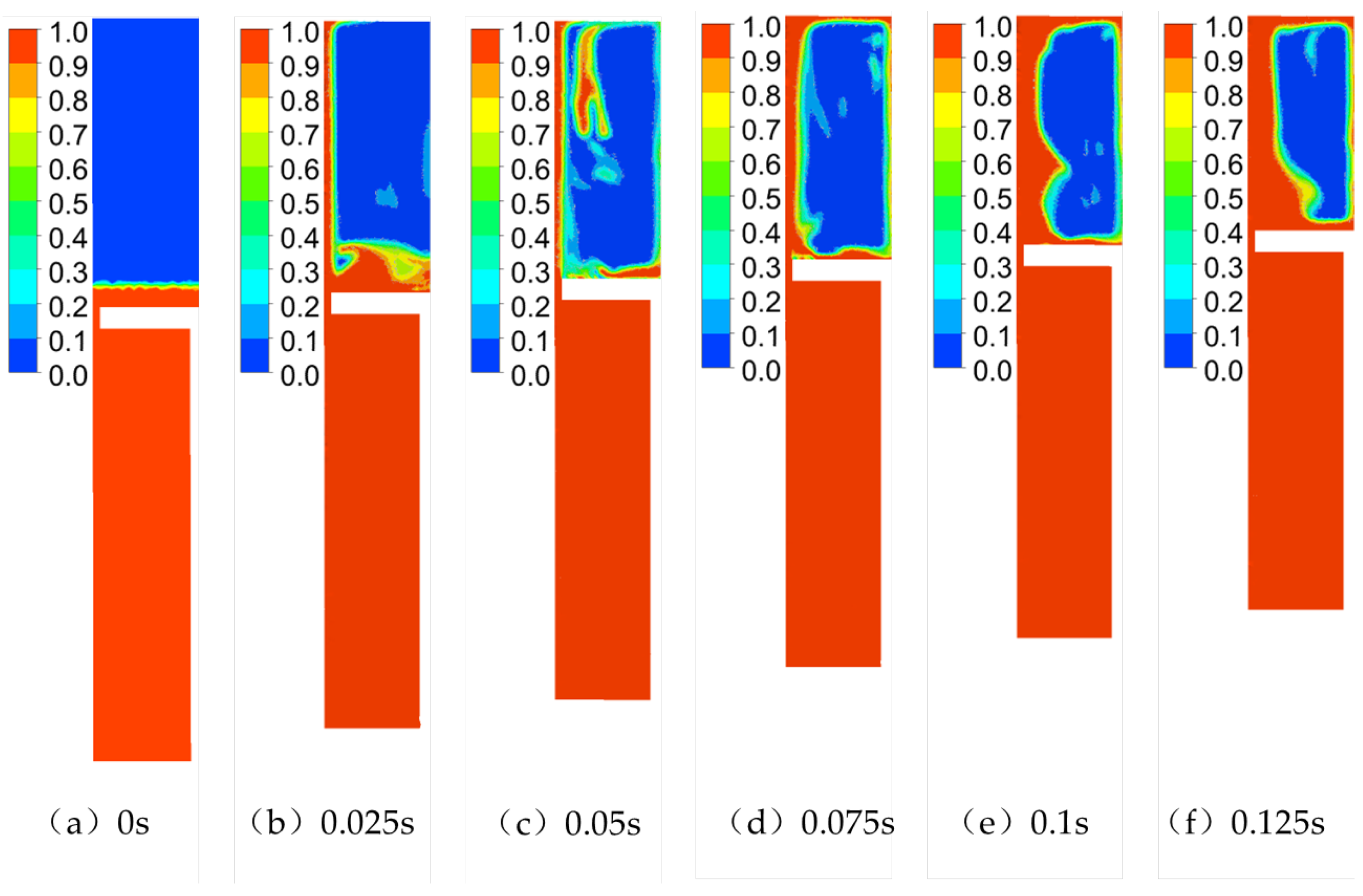
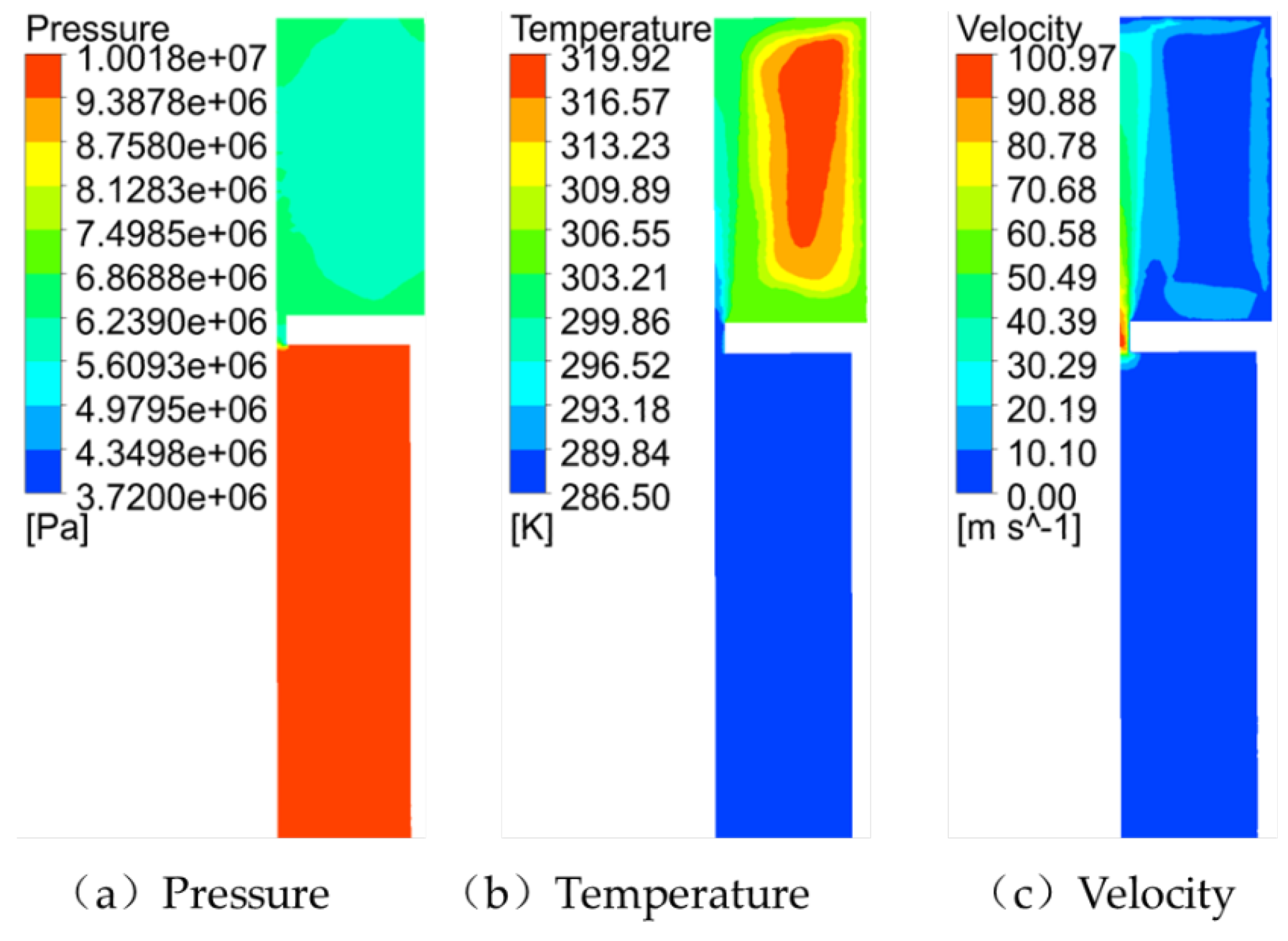

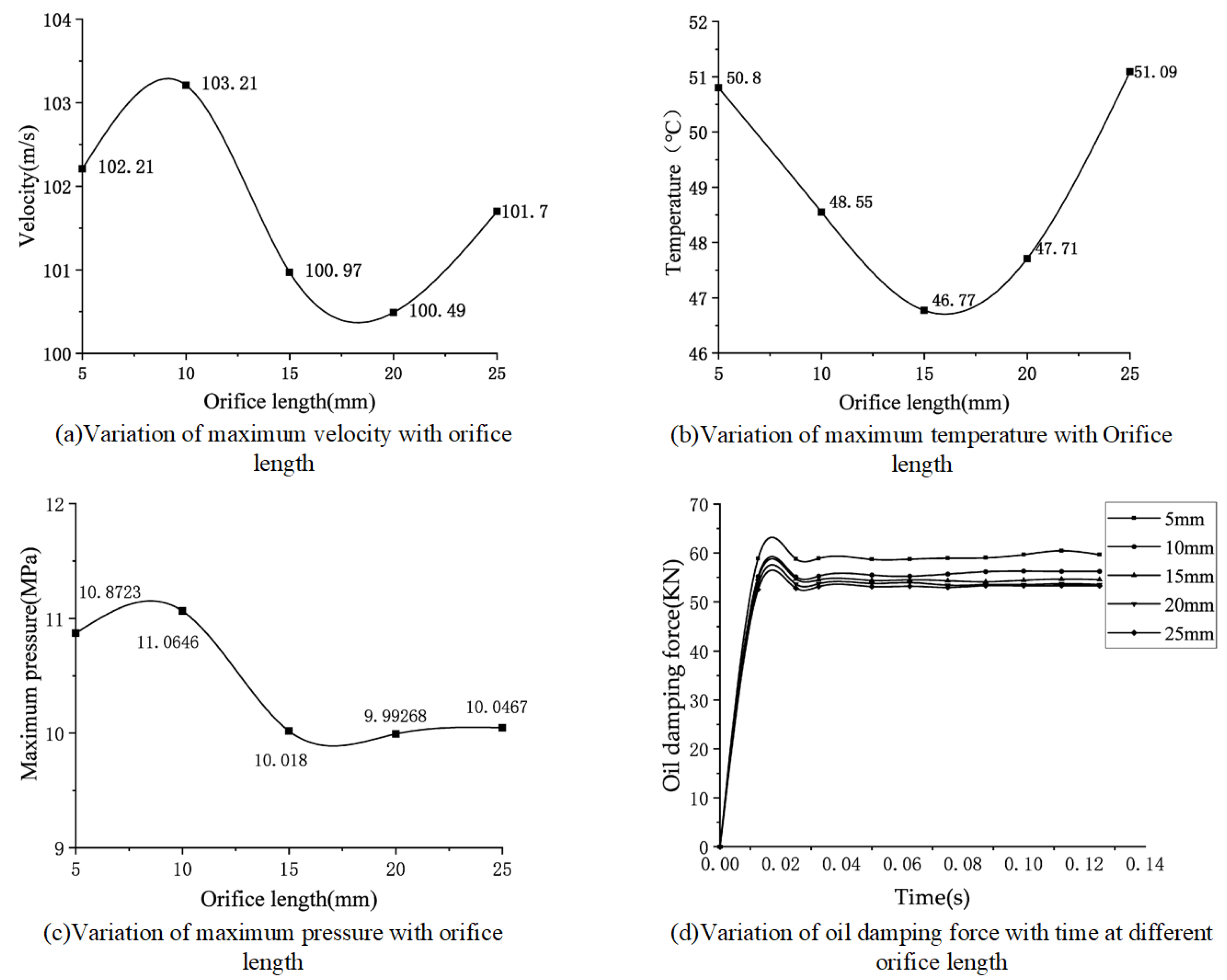

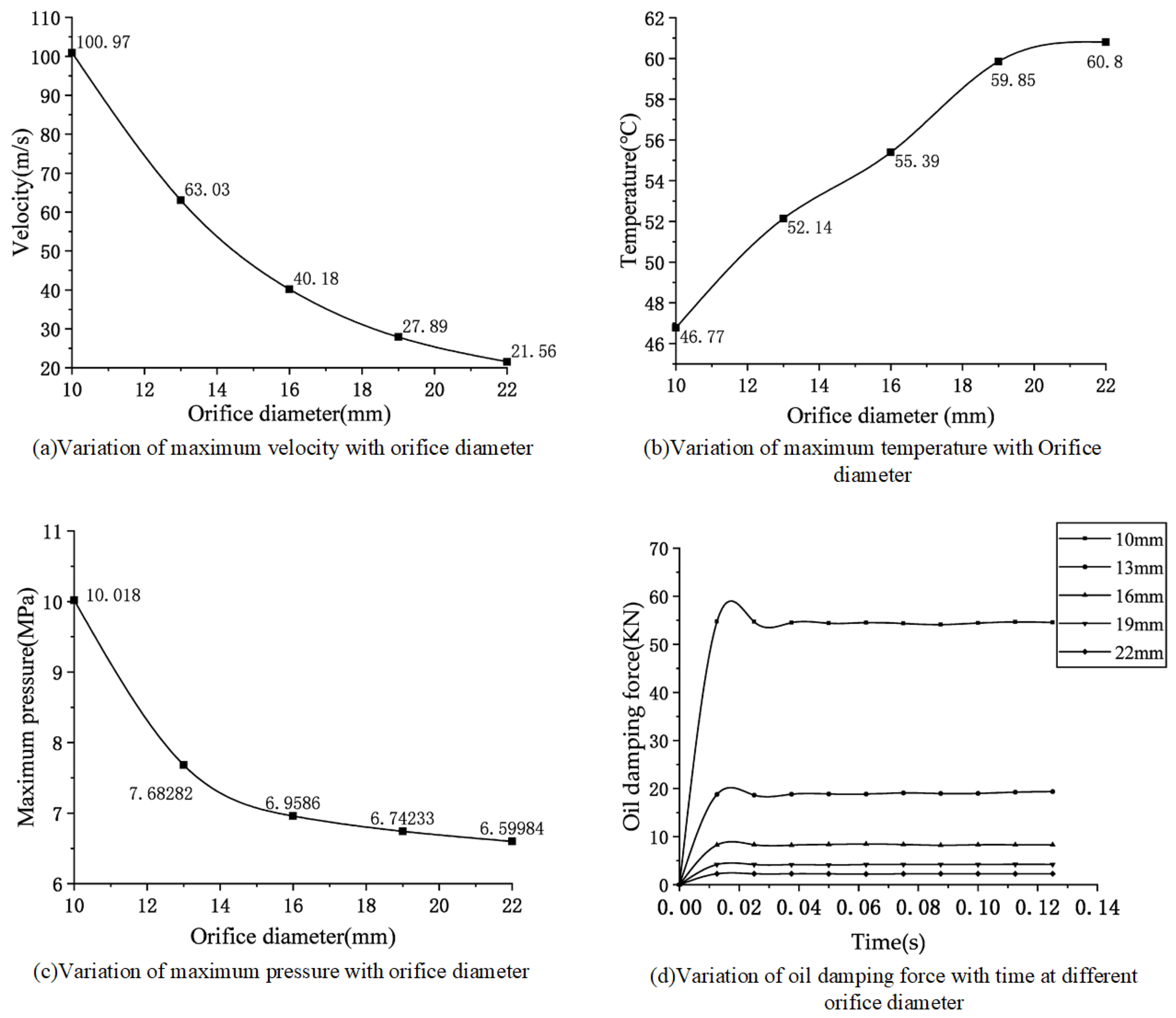
| Number of Mesh Elements | 454,300 | 552,300 | 721,000 | 850,000 | 102,500 | 116,400 | 135,800 |
| Oil damping force (KN) | 49.832 | 53.53 | 52.741 | 54.13 | 54.32 | 54.21 | 53.68 |
| DEFINE_CG_MOTION(piston, dt, vel, omega, time, dtime) |
| { |
| real x [ND_ND]; |
| real y; |
| face_t f; |
| if (time ≤ 1) |
| { |
| vel [0] = −0.4; |
| } |
| } |
| CFD Model Properties | Settings |
|---|---|
| Primary/secondary phase | Nitrogen gas/oil |
| Viscous model | Realizable k-e |
| Gas state | Ideal gas |
| Oil compressibility | Incompressible Newtonian fluid |
| Precharge nitrogen pressure (MPa) | 3 |
| Precharge nitrogen height (mm) | 340 |
| Temperature (K) | 300 |
| Oil dynamic viscosity (Pa s) | 0.01976 |
| Oil density (kg/m3) | 839.3 |
| Time step size (s) | 0.0001 |
| Number of time steps | 1250 |
| Shock Absorber Parameters | Parameter Values | ||||
|---|---|---|---|---|---|
| Oil orifice length (mm) | 5 | 10 | 15 | 20 | 25 |
| Oil orifice diameter (mm) | 10 | 13 | 16 | 19 | 22 |
| compressing velocity (m/s) | 0.4 | 0.5 | 0.6 | 0.7 | 0.8 |
| Piston diameter (mm) | 135 | ||||
| Outer cylinder Diameter (mm) | 150 | ||||
Publisher’s Note: MDPI stays neutral with regard to jurisdictional claims in published maps and institutional affiliations. |
© 2022 by the authors. Licensee MDPI, Basel, Switzerland. This article is an open access article distributed under the terms and conditions of the Creative Commons Attribution (CC BY) license (https://creativecommons.org/licenses/by/4.0/).
Share and Cite
Du, S.; Zhang, C.; Zhou, K.; Zhao, Z. Study of the Two-Phase Flow Characteristics of a Damping Orifice in an Oleo-Pneumatic Shock Absorber. Fluids 2022, 7, 360. https://doi.org/10.3390/fluids7120360
Du S, Zhang C, Zhou K, Zhao Z. Study of the Two-Phase Flow Characteristics of a Damping Orifice in an Oleo-Pneumatic Shock Absorber. Fluids. 2022; 7(12):360. https://doi.org/10.3390/fluids7120360
Chicago/Turabian StyleDu, Siyuan, Changming Zhang, Ke Zhou, and Zhixin Zhao. 2022. "Study of the Two-Phase Flow Characteristics of a Damping Orifice in an Oleo-Pneumatic Shock Absorber" Fluids 7, no. 12: 360. https://doi.org/10.3390/fluids7120360
APA StyleDu, S., Zhang, C., Zhou, K., & Zhao, Z. (2022). Study of the Two-Phase Flow Characteristics of a Damping Orifice in an Oleo-Pneumatic Shock Absorber. Fluids, 7(12), 360. https://doi.org/10.3390/fluids7120360






